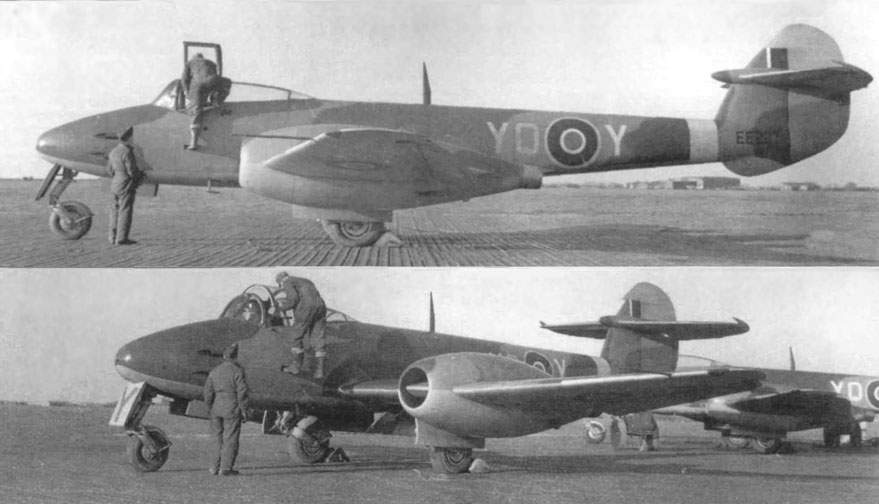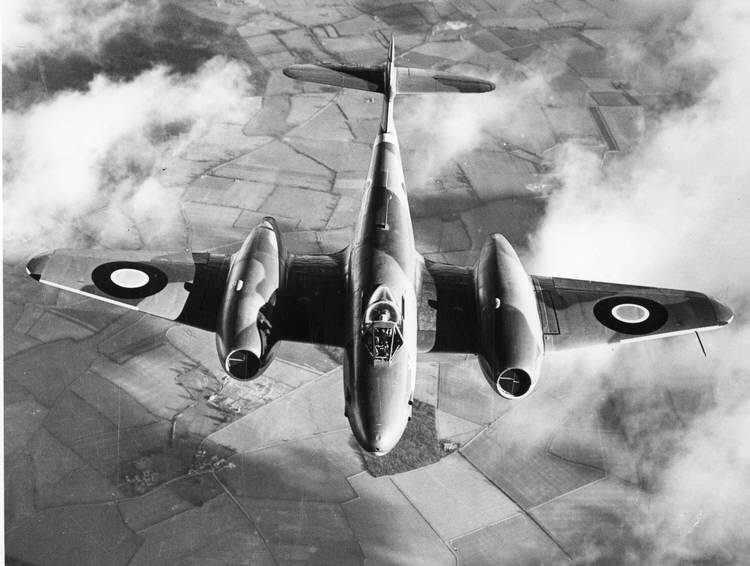The first part of this request is the Meteor F.I
The Meteor F.1 was powered by Rolls Royce Welland turbojets producing 1,700 lbs thrust each. Originally designed to carry 6 cannons, two were deleted on safety grounds and the aircraft was balanced with nose ballast (this was a horrific fix). the aircraft could also carry a 477 litre drop tank.
the Meteor F.1 entered service in July 1944 with 616 squadron trading its Spitfire HF.VIIs for 14 Meteor F.1s. These Meteors only saw combat when they were pressed into service to destroy V-1 Flying bombs, the first being destroyed on August 4th via the usual wing tipping attack. Meteor F.1s only accounted for 14 V-1s, which although small considering the records of other aircraft (300 for Spitfire XIVs) was very good for a single squadron and was exploited for propaganda purposes, regardless of strategic impact. After the invasion of Europe, Meteors were forbidden to fly over the German continent, lest the Germans capture them (The Germans used a much more advanced design of turbojet anyways). In September 1944 616 moved to RAF Debden to help train the USAAF against jet fighter attacks. The knowledge gained showed that jet attacks could be hindered by placing a fighter escort 5,000ft above a bomber formation, so as to catch a jet at the top of its climb, before it could dive. This was the last usage of the Meteor f.1 as it was replaced in December by the Meteor F.3. The F.3 originally shared the shortened Nacelles and Welland engine with the F.1
A great advantage of the Meteor (indeed this is true of most jets) is that it could maintain the same TAS at most altitudes.
Interestingly the Meteor F.1 was faster than all of its piston engined contemporaries up to about 20,000ft but was outclimbed by all of them at all altitudes*.
The aircraft according to the below document* was operationally limited to a ceiling of 15,000ft (apparently there was an aileron imbalance above this altitude). The endurance was also limited to around 45 minutes (477 litre tanks were not fitted operationally but it doesn't say the provision for them is non existent)

A Meteor F.1 of 616 squadron flies over the English countryside.

A pilot enters his mount. Note how the control surfaces hang limp without power. Hydraulic contols?

The first Meteor F.1. Given to the USAAF in exchange for a P-59A Airacomet for comparative testing.

A three view of the same aircraft.

A few of the first Meteor F.3s. Note the extremely short nacelles.

for comparison a Meteor F.3 with long nacelles.

Image detailing the speed performance of the Meteor F.1. This was retrieved from WWII aircraft performance.
*: taken from this source
http://www.wwiiaircraftperformance.org/meteor/meteor-29sept44.pdfNotably, on page 2, the performance of two F.3 (mislabel?) aircraft has been compared (the first has been mislabeled as using a Derwent). The top aircraft with Welland engines should have performance very similar to a Meteor F.1 as the only things changed were canopy type and fuel capacity.
 Author
Topic: Meteor I (Read 3593 times)
Author
Topic: Meteor I (Read 3593 times)


